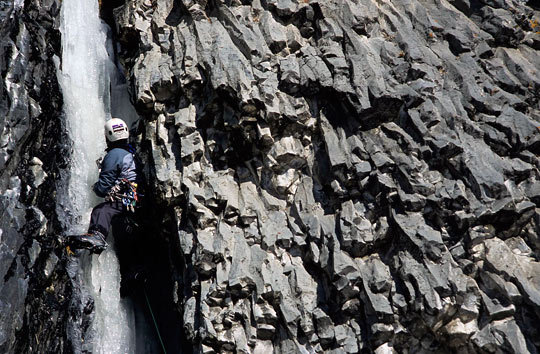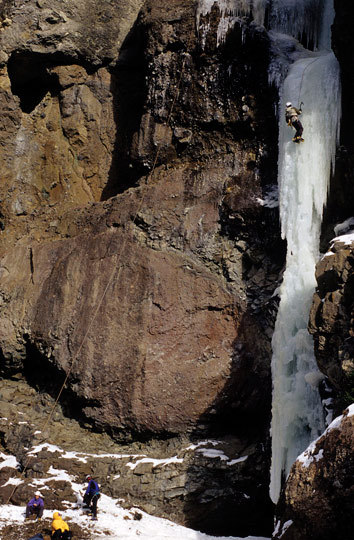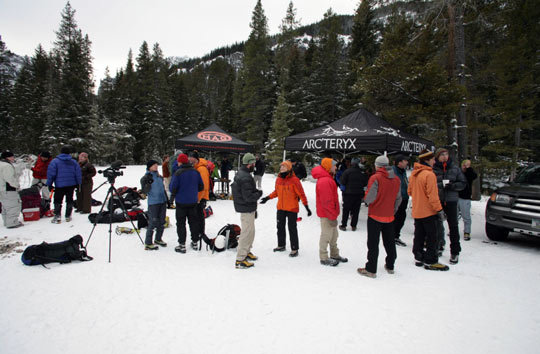
Doug Chabot on the Hyalite Uber-Classic, The Thrill is Gone (WI4 5.8). [Photo] Courtesty of Joe Josephson
In tune with the alpine and ice climbing world for twenty years, Joe “JoJo” Josephson has been a climbing writer and photographer for nearly as long. He is the founder and publisher of Bozeman’s First Ascent Press, and he’s worked an eclectic mix of other positions, including: gear consultant, athlete, photographer, stunt man, guide, sales rep, business manager and ice-access guru. Born and raised in Big Timber, as a fourth generation Montanan, Joe offers his inspiration.
Often in life, you don’t realize how good you have it until it’s gone–or at least under the threat of being taken away. After spending twenty years ice climbing in the greater ranges of the world, including a decade of living in the Canadian Rockies, my concept of world-class ice began with big-ass routes a mile high. But right in my backyard was Hyalite Canyon.
South of Bozeman, Montana, the canyon always has held a great low-key vibe and has been a perfect area for locals. But, with most routes averaging just a single pitch or two, it never occurred to me that Hyalite belonged in the Pantheon of world ice. That all changed in December of 2006.
That winter, the Gallatin National Forest published a new Travel Management Plan, which we ice climbers had been eagerly anticipating. The non-profit Southwest Montana Climbers Coalition met with the Forest Service several times in previous years and felt that it adequately had explained to the bureaucrats just how important the road access was for maintaining Hyalite as a viable ice-climbing venue for the majority of those interested. We expected our access to be improved, or–at the very least–stay the same.
My best and oldest friend is a wildlife biologist who has worked for the Forest Service off and on for twenty years, worked for US Senators and generally has been around the block a few times. He warned me that this Travel Plan and the public input process was little more than a smoke screen: “The Forest Service will adopt nothing they didn’t already want to do.”
“But we had great meetings with them. I think it’ll be OK,” I countered.
My friend nailed it. When the plan came out our access was greatly curtailed by a gate that closed every year on the arbitrary date of January 1. This curbed our twenty-week season into a five-week window, leaving climbers to pray for global warming to produce the weather we needed: freezing cold weather and no snow up to the New Year. In a ski-crazy place like Bozeman, this type of thought will get you run out of town quicker than the last snake oil salesman. Yet the Forest Service sincerely thought they were improving our access. Clearly we had some educating to do.
Over the next four months, we met with the Forest Service numerous times, listened to other user groups, chatted up local and federal politicians, gave Power Point presentations, talked with lobbyists and Senate staff members in Washington, D.C., obtained media coverage, built new coalitions, raised money, lost sleep, scratched our heads and generally wobbled between frustration, glimmers of hope and despondency.
Perhaps it was too many years strung out on nasty Grade 5 with bad ice in front, and the last good screw thirty feet down, but we leveled our heads and kept after it–refusing to fail, refusing to panic, always professional.
To my amazement, by March, the Forest Service bent.
They finally admitted one of their main goals was simply to close the road to avoid the hassles and safety issues of the “Hyalite Rodeo,” the term given to the snowed-up road when it becomes littered with ice climbers in Subarus, motor heads in or on anything that burns two gallons per mile, meek young couples wanting to hold hands in a winter wonderland, ice fishermen hauling sheds of unspeakable squalor, college kids dragging inner tubes, red necks looking to pop a few thousand rounds into the hillside over a case of Schlitz or poor, naive skiers trying to find some peace.

Mark Twight, well known for his incredibly difficult, often unrepeated climbs, as well as his unrelenting ethical stances, teaching on The Sceptre (WI5). [Photo] Courtesty of G. Adam Ruther
Maybe the Forest Service realized ice climbers are a tenacious bunch who were easier to dealt with than to ignore. They agreed to work with ice climbers and other users to manage the road and implement changes through a series of stages. In the end–it could take several years–we’ll address their safety and road concerns, achieve the primary goals of the Travel Plan, give the XC skiers some peace and quiet, and–most importantly–maintain reasonable access to the end of the road where the action begins.
Although the leadership and vision shown by the Gallatin National Forest to work with us was something of a welcomed surprise, my biggest revelation was over Hyalite itself. The distinct chance that our ability to ice climb in Hyalite may be severely curtailed forced me to honestly evaluate Hyalite ice climbing. Trite and simplistic statements like “It’s world class,” do not do the area justice.

The Hyalite Canyon moderate classic, The Mummy II (WI3+) during teaching sessions at the festival. [Photo] Courtesty of Chris Hamilton
Home to all-time classics like Cleopatra’s Needle, Black Magic, Mummy Cooler, Winter Dance–one of the top ten routes in the world (yes, I said world)–and over 140 additional routes in a mere two-and-a-half square miles, Hyalite ice climbing is unique.
Cody’s South Fork might have more vertical, but it’s spread out and inconsistent, with scrappy approaches. Ouray has way more concentrated ice than anywhere else, but most of it is in the ice park, the climbing equivalent of farm-raised salmon (and about as overcrowded). North Conway has killer ice–when it’s not raining. Of course the Canadian Rockies, both the Mecca and Medina of the frozen world, has over ten times the number of routes Hyalite has, and all of them longer–but over an area roughly the size of Maryland. I’ve been to them all. So cut it any way you like; declare yourself a hero because you prefer long alpine or “M-whatever” mixed climbs; stir in whatever hyperbole you favor and pass the single malt… Hyalite is the most concentrated, easily accessible and consistent natural ice climbing venue in North America. And I’m not the only widely-traveled climber to say it’s also my favorite.
Obviously this is a scant overview, if not a dramatic re-telling of the events. But the battle to protect Hyalite access is not yet over. We are all volunteers trying to keep the rest of our lives above water, and there remains much more to do. We need your continued help and support.
Visit www.hyalite.org for more detailed information and the plan for future action steps.
Hyalite Canyon Access Issues
After lengthy discussion, both climbing and skiing advocacy groups reached an agreement with the Forest Service that preserves certain access provisions to Hyalite Canyon. The coalition of various climbing groups involved has made the following statement regarding the current rules.
“In a nutshell, we’ve all agreed that it’s going to take a few seasons of effort, and some degree of trial and error, to sort through the various issues and strategies of implementation. Furthermore, it is agreed that it is easier to start with broad, gradual ideas, see what works, see what doesn’t and then whittle it down; rather than major restrictive changes put in place right away (it’s always easier to take things away than it is to add them later)… the acting Forest Supervisor Tom Puchlerz has unilaterally decided to more or less maintain the status quo for the Hyalite Road for the 2007-08 winter season. Please keep in mind, the status quo refers to the road only. All other aspects of the travel plan will be implemented. That is, no snowmobiles off the road, across the reservoir or beyond the Grotto Falls or Emerald Lake Trailheads.”
What this means for ice climbers and other user groups is still to be determined fully. During the 2007-2008 season, access will be allowed via automobile as it has been in the past. Future seasons’ access remains in jeopardy and is contingent upon the completion of various components of the plans and agreements reached by all involved. Steps include lobbying for and raising highway funding to improve the road into the canyon, which will allay safety concerns on all sides, as well as the construction of separate skiing and snowmobiling trails on differing sides of the reservoir. This construction likely will reduce some of the tensions between various user groups.
The Southwest Montana Climbers Coalition and the Access Fund are the two primary organizations fighting to maintain climbers’ access to Hyalite Canyon. A summary of their efforts, containing more detailed information on this topic, as well as what you can do to help, can be found on the First Ascent Press website.
The 2007 Bozeman Ice Festival
Alpinist Magazine is proud to announce its sponsorship of the annual Arc’Teryx Bozeman Ice Festival, November 29 through December 2, 2007. All proceeds from the festival go toward saving access to this unique and special ice climbing gem.
Along with a full slate of ice climbing clinics–including the very popular “Women’s-Only Day” featuring Kitty Calhoun–slide shows, demos of the latest ice gear, tons of prizes, hanging with some of the best ice climbers on the planet, and the now-legendary wrap party on Sunday, this year’s festival includes very special headliner Guy Lacelle.
Over the last twenty-five years, Guy has climbed an astonishing amount of water ice. 2007 marks his Montana debut–the only major ice venue in the world he has yet to visit. Guy will be presenting a slide show on his favorite 100 ice climbs.
This year the festival will be launching a unique, new twist with the inaugural Grivel North America Hyalite Ice Breaker on Saturday, December 1. The Ice Breaker is an ice climbing competition organized so climbers of any ability and experience (as long as you can lead climb) can be competitive. Check out the festival website for more details.
Space is limited, so reserve your spot and learn more about the details of the festival at www.bozemanicefestival.com.

[Photo] Courtesty of Chris Hamilton